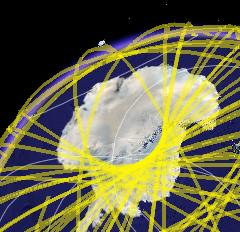The Mac version of the best free software released this side of the millenium is now out, just a little over six months after it was first released for free on Windows. First impressions are that Google Earth Mac is a very solid beta. There are a few features pared from the Windows version, but none that dent the enjoyment or its usability. And I think the Mac version looks better than the Windows version, with the bright “Googley” colors on the panels replaced by a much cooler light blue (official screenshot).

Who is it for?
Amazingly, minimum specs are listed as a 600Mhz G3 with 128MB RAM and 16MB of VRAM, though you need OS X 10.4. (Can OS X 10.4 even run on 128MB RAM?). Google promises (in the release notes) that future versions will run on 10.3.9. Recommended specs are a G4 at 1.2Ghz or faster with 512MB RAM and 32MB VRAM.
So, what works?
I’ve thrown all manner of KML files at it, including some of the biggest baddest ones I could find, as well as large overlays, complex network links and 3D models, and they all work flawlessly (with one exception).
Google’s own 3D-buildings layer renders fine; you can email placemarks and images, use the measuring tool, contribute to Google Earth Community, do location searches and get playable directions, just as with the Windows version. All the layers you find in the Layers panel in the Windows version are available on the Mac version as well, including those from National Geographic.
What’s not included?
There is no embedded browser option. Instead, links lead to your default external browser. Google says (in the release notes) that browser integration is on its way. (BTW, Firefox is smart enough to open KML and KMZ files automatically in Google Earth, while Safari is not.)
GPS, Path, and Polygon are not available in the menus, because these are Plus and Pro features, and those versions are not available yet. Google says, however, (yes, in those rather helpful release notes) that Plus and Pro versions are on their way.
The other things that currently aren’t possible but which Google says soon will be are full-screen mode and the ability to use Gmail to send pics and placemarks instead of your default mail client.
Preferences
In the preferences panel, virtually all preferences are exactly replicated from the Windows version. (One exception is that you can’t choose your display fonts on the Mac version.)
With those exceptions noted, the Mac and PC versions are feature identical.
Further observations
In the Search panel, what’s called “Local Search” on the Windows version becomes “Find businesses.”
There are a few cosmetic glitches I noticed, but no showstoppers, and they’re listed in the release notes. These notes also offer workarounds for older graphics cards, and offer tips on setting your ideal cache size.
For geeks
There is no Applescript support yet, though I’m told it is something that is being worked on (and the application does list itself as Apple scriptable, though there is no AppleScript dictionary when you go looking.)
This version is not a universal binary, but it runs on Rosetta (albeit slowly, I am told). There is a universal binary version in the works.
This application was developed on Qt, the cross-platform development platform (as first noted here). I assume this means the Linux version is not too far behind.
Google Earth for Mac will obviously not play nice with web applications that require Microsoft’s ActiveX or which hack the Windows application for scriptability, so no GlobeGlider for the Mac.
The only way I’ve gotten Google Earth Mac to crash is by having it try to access a password-protected KML file, just like the one Jason Birch posted in his comment on a recent Ogle Earth article about whether you can password-protect KML files. I suspect it’s because the Mac version doesn’t have a built-in browser yet.
 And finally, a pet peeve: This wonky button.
And finally, a pet peeve: This wonky button.
[Update: 21:17 UTC: The release notes and the Google Earth download site differ somewhat in the recommendation for what is the minimum spec. On the site FAQ, “500Mhz” (I presume from a G4) and 256MB RAM are considered a minimum for the Mac.]
 While the plug-in is only useful to SketchUp users, all Google Earth users can display the exported files. Some of the more impressive examples are available for download at the bottom of
While the plug-in is only useful to SketchUp users, all Google Earth users can display the exported files. Some of the more impressive examples are available for download at the bottom of  And how. Mart√≠n posts a few “samples of KML files” in
And how. Mart√≠n posts a few “samples of KML files” in 